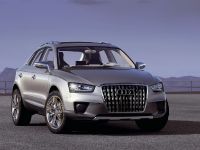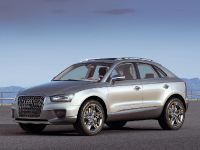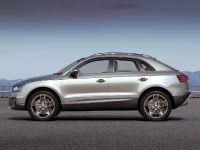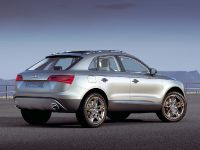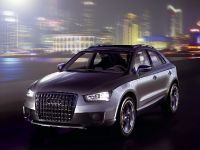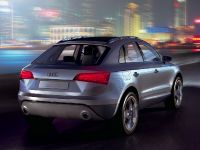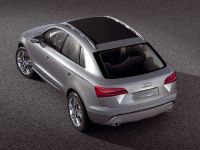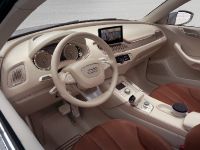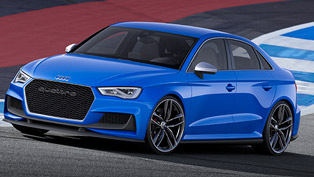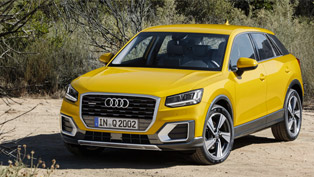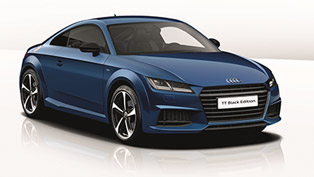Audi Cross Coupé quattro
The silhouette is typical Audi; the design of the study, painted in Liquid Silver, is highly reminiscent of the sporty models produced by the Ingolstadt brand. The proportions and the large 20" wheels point clearly towards the offroad potential of the Cross Coupé quattro. A new element is the fabric folding roof, which, when it is open, gives optimum levels of headroom and fresh air. The hood is opened and closed electrically.
The transversely installed four-cylinder inline TDI engine with common-rail fuel injection and piezo injectors is a completely new development. With power output of 204 bhp and 400 Nm of torque, it gives the vehicle a sporty performance and a surprising degree of efficiency. On average the ultra-modern 2.0 TDI needs just 5.9 litres of diesel per 100 km. The diesel particulate filter and Bluetec system reduce soot and nitric oxide emissions effectively. Even today, the Audi Cross Coupé quattro satisfies the emissions standards of the future.
The quattro permanent four-wheel drive system is a matter of course on an Audi with offroad potential. A Haldex clutch ensures that traction is precisely distributed according to the situation. The sporty Audi S tronic dual-clutch gearbox executes gearshifts in a matter of milliseconds.
The running gear, featuring a McPherson-strut front axle and a four-link rear axle is perfect for sporty and agile handling that retains a high degree of stability and makes cornering distinctly fun. As an additional quality, the driving comfort of the running gear impresses on all types of road and in rough terrain, meeting even the standards expected of a vehicle in a higher class. Ceramic brake discs promise excellent, non-fading deceleration. 20" wheels give the Cross Coupé quattro the ground clearance required.
Numerous electronic systems support the driver. The Audi drive select system makes it possible to preselect three highly individual configurations for the engine, gearbox, steering and adaptive shock absorbers. The result: a car that can be enjoyed in three completely different ways.
Besides the standard "dynamic" drive select mode and the "sport" setting, the Audi Cross Coupé also has the "efficiency" driving program. Here, the engine map and the shift points are modified to support a particularly economical driving style. In addition, the system deactivates components that are particularly energy-hungry, for example the air-conditioning compressor.
Another innovation is the MMI control panel, which is operated by a touch pad. The monitor of the system employs, for the first time, dual-view technology. The system can produce different images for the driver and front-seat passenger. These images are only visible when viewed from a specific angle. This allows the driver to read data from the on-board computer while the front passenger watches a TV programme, listening to the sound through headphones.
The sound system with the prominent extending tweeters sets a new infotainment standard in the class. The ambient lighting with numerous light sources gives the interior a stylish ambience, even at night.
The Design
The design of the four-door study presents itself as a further step in the evolution of the current Audi style. The prominent single-frame radiator grille, the proportions, with large areas of metal and narrow glazing at the sides, and the powerful rear end identify the SUV as a relative of the Audi Q7. The robust-looking sill area with its colour offset and the heavily embossed dynamic line above it emphasise the vehicle's offroad character.
The study, painted in Liquid Silver, has a heavily segmented side area with gently climbing shoulder line and accentuated horizontal rear end. These elements are borrowed from the A5 coupé and are essential factors of this model's independence. A typical Audi feature is the roof, gently curved and carried on the slim A and C pillars, evoking a coupé silhouette. Also typical of a coupé are the frameless doors with fully retracting windows. And the short overhangs also help to make the overall proportions appear so dynamic.
As previously seen on the Audi Shooting Brake study, the trapeze of the large single-frame grille with its vertical slats gives the front end an emphatically self-assured appearance. Particularly eye-catching are the three-dimensional main headlights, which incorporate LED technology. The reflector dishes concentrate the light to form a powerful, uniform beam whose white tone is easy on the eye, even on long night-time journeys. Naturally, the daytime running lights, which take the form of a horizontal strip, also employ LED technology. In addition to its design qualities, this also provides for an especially low level of energy consumption.
For the first time, the Audi Cross Coupé quattro employs LED technology for both headlights and cornering lights. Here, the lens, reflector and beam deflector are integrated in a single component. LED technology is also used for the main-beam headlights.
Viewed from the rear, the shoulder areas are especially prominent, separating the side areas from the D pillars and at the same time underlining the dynamic character of the Cross Coupé quattro. The tailgate embraces both the sides and the rear. The lights project deeply into both the side panels and the tailgate. The tailgate hinge is integrated into the roof rails. The tailgate itself opens up to reveal a wide, easy-to-load opening to the luggage compartment. Here you can find the same multifunctional rail system that has been well proven ever since its debut in the A6 Avant. The volume of the luggage compartment is 450 litres when loaded up to the edge of the window.
The rear lights are deeply embedded in the body of the vehicle, underlining the study's innovative design. The transparent red covers in a supine U-shape give a clear view of the LED technology. The area of the lights is segmented by delicate fins, indicating the very high degree of precision. Again here, the turn signal lights form narrow, horizontal strips. The Cross Coupé is instantly recognizable, even at night.
The body of the Audi Cross Coupé quattro makes optimum use of the compact road space of an A-class vehicle. With a length of 4.38 m, a width of 1.82 m and a wheelbase of 2.60 m, it is only slightly larger than the A3 Sportback. The study shares excellent economy of space with this model, not least thanks to the transversely installed engine. The height of 1.60 m (18 centimetres higher than the Sportback) is typical of an SUV and gives the occupants a comfortable, upright seating position.
The interior
All areas of the Audi Cross Coupé quattro interior offer top quality and solutions that are as elegant as they are ergonomically perfect. The pale basic colour, off white, generates an impression of quality and a feeling of spaciousness. In addition, clear contrasts between the different materials add to the visual and haptic surprises. For example, while all the leather surfaces are in the colour saddle brown, an appealing contrast is generated by the high-gloss and matt surfaces of the different types of leather.
Seating is provided by individual seats in the front and a rear bench with two full-size seats. The complete seating system is upholstered in saddle brown leather. All four seats offer good side support and excellent long-distance comfort.
The cockpit area is heavily inclined towards the driver – typical of a modern Audi. The controls can be found here, while the front-passenger area is emphatically neat and architecturally clear-cut. In turn, the dashboard and doors are connected by flowing lines, while the cockpit itself is succinct and organically integrated.
In the upper section of the centre console, beside the instrument dials, under the dome-shaped hood behind the steering wheel, the retractable MMI display is optimally situated in the driver's field of vision to provide driving information. A new element is the perforated trim strip in the dashboard, linking the centre console and the front-passenger area. The perforated surface marries form and function, for it allows the air-conditioning system to provide indirect, draught-free ventilation through more than 4,600 holes.
The MMI terminal on the centre console is extremely neat. The central control element and the six hard keys are the simplest way imaginable to operate the vehicle and infotainment functions.
Information is output on the retracting MMI monitor in the upper section of the centre console. Furthermore, selected information – for example about incoming text messages and phone calls – can be displayed directly in the windscreen via a laser projection. A further feature of this technology: electronically authorised tags or parking permission stickers can be projected in mirror image, meaning that they can be read from outside, at the edges of the windscreen, and are visible even once the vehicle has been switched off.
In addition to the MMI terminal, the Cross Coupé quattro also has a touch-sensitive sensor field (touch pad) in front of the MMI control element. Like on a laptop, this can be used, for example, to move image sections of the map display. The touch pad is also able to recognise characters written with your finger – even Chinese characters – and to process these as commands.
The air-conditioning system also has a new control element – the touch wheel. Pressing it with your fingertip allows the rotary movements of traditional rotary/pushbutton controls to be simulated and all functions such as temperature setting and blower speed to be controlled intuitively. An electronic driver/passenger recognition sensor "tells" the system which part of the two-zone climate control has to be adjusted. This makes it possible to do without a second, superfluous control panel.
The large fabric folding roof is a particular visual highlight of the Audi Cross Coupé quattro – regardless of whether it is seen from the inside or outside. Opened and closed electrically, it opens up the view to the sky from the A pillar almost as far as the tailgate and across nearly the whole width of the roof, allowing almost the same degree of fresh air as that provided by convertibles.
The drivetrain
The Cross Coupé quattro is powered by an all-new 2.0 TDI diesel engine, the first example of the new generation of four-cylinder TDI engines in the Volkswagen/Audi Group. This 150 kW (204 bhp) power plant marries distinctly sporty characteristics – peak torque is 400 Nm between 2,000 and 3,500 rpm – with a high level of refinement and an impressive degree of economy and efficiency. The compact yet powerful sports car needs just 5.9 litres of diesel for 100 km.
The fuel/air mixture is prepared by a common-rail system of the latest generation, which is also employed by Audi in the V6 TDI engines. It has a high-pressure pump and common manifold (rail) for each of the four cylinders. The maximum injection pressure is 2,000 bar.
The high injection pressure provides for even finer atomisation of the fuel and thus for a better mixture and more efficient combustion. Piezo injectors allow the number of injection sequences per working cycle to be varied almost at will. A strategy that provides for both softer combustion and for lower untreated emissions – in other words, top engine acoustics and at the same time extremely low overall emissions. Without doubt, the 2.0 TDI engine is the current benchmark in its class in both disciplines.
More innovative technology on board reduces overall emission even further. For example, the new engine is not only combined with a diesel particulate filter, but also employs the Bluetec injection system to reduce nitric oxides effectively.
The heart of the Bluetec technology is a special catalytic converter downstream of the oxidising catalyst and the particulate filter.
The second component in the system is an additional tank containing a watery solution of carbamide (urea). Small quantities of the solution, known as "AdBlue", are injected into the exhaust system. The hot exhaust gases break the solution down to form ammonia, which splits the nitric oxides into nitrogen and water. The system will remain effective for the entire service life of the vehicle.
With such extremely clean Bluetec diesel engines, Audi is continuing its tradition of leading from the front in matters of diesel engine technology. In 1989 it was the Ingolstadt brand that developed direct injection technology. Since then the diesel engine has become around 30 percent more economical and the Euro 4 European emission standard has reduced particulate emissions by 93 percent. Long before it came into force, Audi had models on the market that satisfied this standard, even without a particulate filter.
This equipment enables the Audi Cross Coupé quattro even today to meet the most stringent regulations currently known, the Euro 6 standard and the strict US emissions legislation.
The quattro permanent four-wheel drive system provides for power transmission – what else would you expect from an Audi with a powerful engine and offroad qualities? An electronically controlled viscous clutch provides variable power distribution between the front and rear wheels, just as it does on the Audi A3 quattro and the Audi TT.
The sporty Audi S tronic direct-shift gearbox enables the driver to execute a gear change within a fraction of a second without a clutch pedal. If he wants, the gearbox will make all gear changes fully automatically. And if he wants to change gear manually, he can do this with the shift paddles in the steering wheel. The newly designed selector lever with integrated control knob for selecting gear is a further development of the shift-by-wire system.
The running gear
The second pillar on which the excellent driving dynamics are built is the elaborate running gear, with McPherson-strut front axle and four-link independent-suspension rear axle. Large 20" wheels with size 245/45 R20 tyres also contribute to driving fun and safety.
The dynamic suspension is designed to give sporty, agile handling and a high degree of stability while making cornering distinctly fun. As an additional quality, the running gear impresses with a driving comfort that would satisfy the standards expected in higher vehicle classes.
The capability of the engine is matched by the potential of the brake system with its large-diameter discs.
The electromechanical steering system with speed-dependent power steering provides for superlative handling. It combines optimum steering feel with low sensitivity to agitation from the road surface and significantly reduced power consumption.
The special qualities of the four-link axle are based on the functional separation of the longitudinal and lateral force absorption points. On the one hand, this allows a high degree of lateral rigidity, which favours superior dynamics and driving safety. On the other hand it also allows a high degree of longitudinal suppleness, improving ride comfort.
Individual springs and shock absorbers provide vertical support. The shock absorbers are located close to the wheels, allowing a very large load width in the luggage compartment. A tubular transverse stabiliser is secured to the subframe with highly rigid bonded-metal rubber mounts. This effectively reduces the body's tendency to roll and thus positively influences the transmittable lateral forces – ultimately improving the vehicle's handling.
The shock absorbers employ the Audi magnetic ride system, an innovative technology that has already impressed in the Audi R8 high-performance sports car and in the TT. Instead of conventional shock absorber oil, a magneto-rheological fluid is used, a fluid whose viscosity is influenced by an electromagnetic field. This effect means that the shock absorber map can be changed at any time simply by applying a voltage to the solenoids.
Audi magnetic ride exploits this property to ensure that the correct shock absorber force is available in all driving situations and thus optimising ride comfort and driving dynamics. A computer equipped with sensor technology determines the prevailing driving situation in a matter of milliseconds. Here, the driver can choose between two driving programs, depending on whether he wants to drive with a sportier style – requiring low viscosity of the magneto-rheological fluid – or with a greater emphasis on ride comfort.
Excellent performance, low weight and maximum mileage are offered by the ceramic brakes. Here, the discs are produced from a ceramic material reinforced with carbon fibres – a combination that has long been proven in the aviation industry.
It only takes a glance to see the ceramic discs against the anthracite grey paint of the special aluminium callipers. The advantage of ceramic brakes over steel discs is the weight saving of some 20 kg, which improves drivability and comfort. The high level of resistance to abrasion allows a service life of up to 300,000 km. However, its most important strength is its lack of sensitivity to extreme loads.
